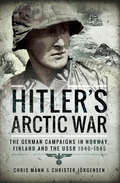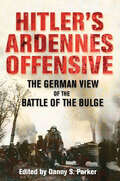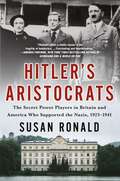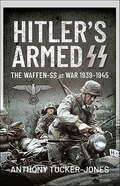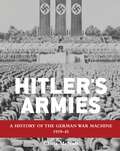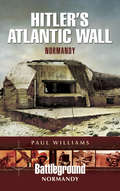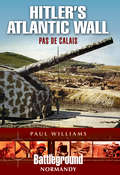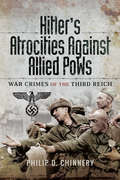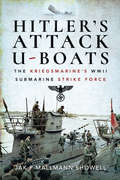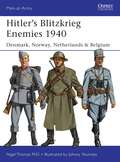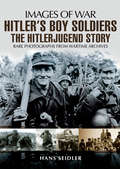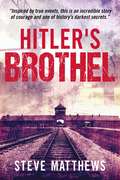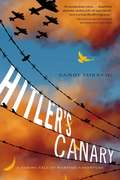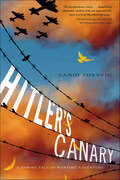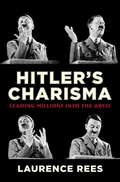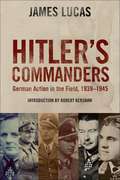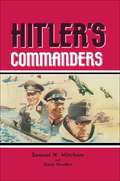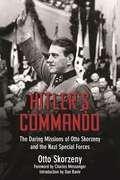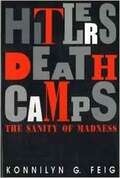- Table View
- List View
Hitler's Arctic War: The German Campaigns in Norway, Finland and the USSR 1940–1945
by Chris Mann Christer JörgensenIn the past the German General Staff had taken no interest in the military history of wars in the north and east of Europe. Nobody had ever taken into account the possibility that some day German divisions would have to fight and to winter in northern Karelia and on the Murmansk coast. (Lieutenant-General Waldemar Erfurth, German Army). Despite this statement, the German Armys first campaign in the far north was a great success: between April and June 1940 German forces totaling less than 20,000 men seized Norway, a state of three million people, for minimal losses. Hitlers Arctic War is a study of the campaign waged by the Germans on the northern periphery of Europe between 1940 and 1945.As Hitlers Arctic War makes clear, the emphasis was on small-unit actions, with soldiers carrying everything they needed food, ammunition and medical supplies on their backs. The terrain placed limitations on the use of tanks and heavy artillery, while lack of airfields restricted the employment of aircraft.Hitlers Arctic War also includes a chapter on the campaign fought by Luftwaffe aircraft and Kriegsmarine ships and submarines against the Allied convoys supplying the Soviet Union with aid. However, Wehrmacht resources committed to Norway and Finland were ultimately an unnecessary drain on the German war effort. Hitlers Arctic War is a groundbreaking study of how war was waged in the far north and its effects on German strategy.
Hitler's Ardennes Offensive: The German View of the Battle of the Bulge
by Danny S. Parker"Hitler's Ardennes Offensive - known to the Germans as Wacht am Rhein and to the Allies as the Battle of the Bulge - was intended to turn the course of the war in Germany’s favor. The ferocity of the offensive took the Allies by surprise and it has gone down in history as one of the most significant campaigns of the war. Many accounts of the battle have tended towards the perspective of the Allied victors, lacking firsthand detail about German intentions and operations. This book, however, vividly recounts how Hitler and his generals perceived the progress and ultimate failure of their final great assault. In this impressive volume, historian Danny S. Parker has brought together many rare documents representing the views of all the major personalities within the German army headquarters. These include Oberstgruppenführer Josef Dietrich and Generalmajor Fritz Krämer, General Hasso von Manteuffel, Generalfeldmarschall Wilhelm Keitel and others. Everything from preparations for the offensive, to attitudes during the campaign and after it was brought to a close are covered, providing a fascinating and invaluable record of the German perspective - essential for a balanced view of the battle."
Hitler's Aristocrats: The Secret Power Players in Britain and America Who Supported the Nazis, 1923–1941
by Susan RonaldSusan Ronald, acclaimed author of Hitler's Art Thief takes readers into the shadowy world of the aristocrats and business leaders on both sides of the Atlantic who secretly aided Hitler and Nazi Germany.Hitler said, “I am convinced that propaganda is an essential means to achieve one’s aims.” Enlisting Europe’s aristocracy, international industrialists, and the political elite in Britain and America, Hitler spun a treacherous tale everyone wanted to believe: he was a man of peace. Central to his deception was an international high society Black Widow, Princess Stephanie Hohenlohe-Waldenburg-Schillingsfürst, whom Hitler called “his dear princess.” She, and others, conspired for Hitler at the highest levels of the British aristocracy and spread their web to America's wealthy powerbrokers.Hitler’s aristocrats became his eyes, listening posts, and mouthpieces in the drawing rooms, cocktail parties, and weekend retreats of Europe and America. Among these “gentlemen spies” and “ladies of mystery” were the Duke and Duchess of Windsor, Lady Nancy Astor, Charles Lindbergh, and two of the Mitford sisters. They were the trusted voices disseminating his political and cultural propaganda about the “New Germany,” brushing aside the Nazis’ atrocities. Distrustful of his own Foreign Ministry, Hitler used his aristocrats to open the right doors in Great Britain and the United States, creating a formidable fifth column within government and financial circles.In a tale of drama and intrigue, Hitler’s Aristocrats uncovers the battle between these influencers and those who heroically opposed them.
Hitler's Armada: The Royal Navy and the Defence of Great Britain April–October 1940
by Geoff HewittHitler's Armada examines the aborted German invasion of 1940 in a fresh and original manner by looking past the myths and legends which have subsequently surrounded it, in order to arrive at significant new conclusions by referring back to the actual events.The book presents fascinating detail of Hitler's Operation SEALION and, by study of its weaknesses, demonstrates that control of the sea, not the air, was the critical factor. It also questions whether the traditional British view of the importance of the Battle of Britain as the key factor in the prevention of invasion is really tenable.The importance of the Royal Navy during this period, generally overlooked, is brought into sharp focus and, possibly for the first time, the actual dispositions of the Royal Navy anti-invasion forces are presented in detail. The author examines the relative strengths of the two sides drawing interesting conclusions about the inadequacies of the German resources particularly and their reliance on mine laying.The author discusses the conflict between air and sea power in the months leading up to the summer of 1940, concluding that, at this stage of the Second World war, air power was far from supreme.The findings of the author may be controversial, but the process by which they are reached strongly supports their validity.
Hitler's Armed SS: The Waffen-SS at War, 1939–1945
by Anthony Tucker-JonesThe Waffen-SS was one of the most formidable German military formations of the Second World War – feared for its tenacity and ruthlessness in battle, notorious for the atrocities it committed. As a distinct fighting force derived from the Nazi Party’s SS organization, it stood apart from the other units of the German army. Its origins, structure and operational role during the war are often misunderstood and the controversy still surrounding its conduct make it difficult today to get an accurate picture of its actions and its impact on the fighting. Anthony Tucker-Jones, in this concise and fluently written account, provides an absorbing and clear sighted introduction to it. He traces its development under Himmler from modest beginnings in the early 1930s as Hitler’s personal protection squad of elite soldiers to a force which eventually amounted to thirty-eight divisions. Towards the end of the war many Waffen-SS units were formed from foreign volunteers and proved to be of poor quality, but its premier panzer divisions thoroughly deserved their reputation as tough fighters. Through accounts of the Waffen-SS’s major battles on the Eastern Front, in Normandy and finally in defence of Germany, a detailed picture emerges of the contribution it made to the German war effort, especially when Hitler’s armies were in retreat. The parts played by the most famous Waffen-SS formations – Das Reich, Totenkopf, Leibstandarte SS Adolf Hitler among them – and their commanders – men like Dietrich and Hausser – can be seen in the wider context of the war and Germany’s defeat.
Hitler's Armies
by Chris McnabThe definitive work on Hitler's war machine charting its evolution from the formidable force which won stunning victories during the Blitzkrieg in 1940, to the hard campaigns it fought in the deserts of North Africa and the frozen wastelands of the Soviet Union to the eventual retreat to the Fatherland itself. Drawing upon Osprey Publishing's unique archive, this volume expertly weaves together the story of the development and deployment of Hitler's armies displayed alongside a stunning collection of original artwork and photographs to show the kit and equipment of the various land forces.
Hitler's Art Thief: Hildebrand Gurlitt, the Nazis and the Looting of Europe's Treasures
by Susan RonaldThe sensational story of a cache of masterpieces not seen since they vanished during the Nazi terror—a bizarre tale of a father and aged son, of secret deals, treachery and the search for truth.The world was stunned when eighty-year old Cornelius Gurlitt became an international media superstar in November 2013 on the discovery of over 1,400 artworks in his 1,076 square-foot Munich apartment, valued at around $1.35 billion. Gurlitt became known as a man who never was - he didn't have a bank account, never paid tax, never received social security. He simply did not exist. He had been hard-wired into a life of shadows and secrecy by his own father long before he had inherited his art collection built on the spoliation of museums and Jews during Hitler's Third Reich. The ensuing media frenzy unleashed international calls for restitution, unsettled international relations, and rocked the art world. Susan Ronald reveals in this stranger-than-fiction-tale how Hildebrand Gurlitt succeeded in looting in the name of the Third Reich, duping the Monuments Men and the Nazis alike. As an "official dealer" for Hitler and Goebbels, Hildebrand Gurlitt became one of the Third Reich's most prolific art looters. Yet he stole from Hitler too, allegedly to save modern art. Hitler's Art Thief is the untold story of Hildebrand Gurlitt, who stole more than art-he stole lives, too.
Hitler's Atlantic Wall: Normandy (Battleground Normandy)
by Paul WilliamsThis highly informative book begins with an examination of the background to Germany's primary military objectives in relation to the western end of their self-styled 'Fortress Europe' including the early foundation of shore defences in northern France.In 1941, there was a switch in emphasis of the Atlantic Wall's role from attack to defence. Beach defences became more elaborate and the Nazi-controlled Todt Organisation began a massive building programme constructing new bunkers and reinforcing existing sites, using forced labour.Hitler appointed Rommel to formulate Germany's anti-invasion plans in early 1944. At the same time the Allies were making extensive studies of the fortifications and preparing for the challenge of overcoming this most formidable of obstacles.Using, in many cases, previously unpublished accounts of the soldiers on the ground this book follows Britain's 79th Armoured Division, Sir Percy Hobart's 'Funnies', as they utilised their unique weaponry in support of Allied efforts to ensure the success of the invasion. The author draws on British, American, Canadian and German sources.Hitler's Atlantic Wall Normandy also includes information on war cemeteries along with travel information and accommodation suggestions and a guide to the relevant museums.
Hitler's Atlantic Wall: Pas de Calais (Battleground Normandy)
by Paul WilliamsThis well-illustrated book describes the massive effort that the occupying Nazi forces put into the construction of the Eastern section of the Atlantic Wall. While the D-Day invasion was unaffected by the fortifications in this area, they still posed a significant threat. This came from the mighty gun batteries (such as Batteries Todt and Lindemann) that threatened Channel shipping and the South Coast of England, and, while isolated from the main Allied advance, the Festung ports of Calais, Boulogne and Dunkirk were denied to Allied use. This was of major strategic significance as the lines of supply were becoming ever longer and more vulnerable.Using rare archive material, this book takes the reader on a fascinating journey along the coast that Hitler was wrongly convinced would be the site of the Allied landings. Hitlers Atlantic Wall Pas de Calais tells the history of how and why the giant batteries were built, the origins of their weaponry and the ingenious engineering and military operations that defeated them finally.
Hitler's Atrocities Against Allied PoWs: War Crimes of the Third Reich
by Philip D. Chinnery“A chilling description of the ordeals that captured men and women were put through by the Third Reich regime and their Italian allies.” —Daily MailSeventy years ago, the Nuremberg Trials were in full swing in Germany. In the dock were the leaders of the Nazi regime and most eventually received their just desserts. But what happened to the other war criminals?In June 1946, Lord Russell of Liverpool became Deputy Judge Advocate and legal adviser to the Commander in Chief for the British Army of the Rhine in respect of all trials held by British Military Courts of German war criminals. He later wrote:“At the outbreak of the Second World War, the treatment of prisoners was governed by the Geneva Prisoner of War Convention of 1929, the Preamble of which stated that the aim of the signatories was to alleviate the conditions of prisoners of war.“During the war, however, the provisions of the Convention were repeatedly disregarded by Germany. Prisoners were subjected to brutality and ill-treatment, employed on prohibited and dangerous work, handed over to the SD for ‘special treatment’ in pursuance of Hitler’s Commando Order, lynched in the streets by German civilians, sent to concentration camps, shot on recapture after escaping, and even massacred after they had laid down their arms and surrendered.”Tens of thousands of Allied prisoners of war died at the hands of the Nazis and their Italian allies. This book is for them lest we forget.“A sobering and harrowing book, detailing many forgotten crimes committed against POWs who should have been offered the protection of the Geneva Convention, but tragically were not.” —Recollections of WWII
Hitler's Attack U-Boats: The Kriegsmarine's WWII Submarine Strike Force
by Jak P. Showell“A definitive introduction by a highly recognized authority who writes beautifully and clearly.” —Naval Historical FoundationThe fact that German submarines almost managed to cut off Britain’s vital imports during the First World War hadn’t been forgotten by Hitler—and when, in 1935, he repudiated the Treaty of Versailles, Britain, magnanimously, signed an Anglo-German Naval Agreement. This allowed the Germans to build their submarine strength up to one third of the Royal Navy’s tonnage.When war broke out in 1939, German U-boats went quickly into action, but with only four years of production and development, the main armament of these submarines was considerably weaker than equivalent boats in other navies and many other features, such as living conditions, were also significantly inferior. Yet, the German U-boat onslaught against British merchant ships in autumn 1940 was highly successful because the attacks were made on the surface at night and from such close range that a single torpedo would sink a ship.Soon, though, Allied technology was able to detect U-boats at night, and new convoy techniques, combined with powerfully armed, fast modern aircraft searching the seas, meant that by 1941 it was clear that Germany was losing the war at sea. Something had to be done. The new generation of attack U-boats that had been introduced since Hitler came to power needed urgent improvement. This is the story of the Types II, VII, and IX that had already become the ‘workhorse’ of the Kriegsmarine’s submarine fleet and continued to put out to sea to attack Allied shipping right up to the end of the war. The Type II was a small coastal boat that struggled to reach the Atlantic; the Type VII was perfectly at home there, but lacked the technology to tackle well protected convoys; while the Type IX was a long-range variety modified so it could operate in the Indian Ocean.This book by the renowned Kriegsmarine historian explores these attack U-boats at length, including details of their armament, capabilities, and crew facilities; the story of their development and operational history; and just what it was like to operate such a vessel.
Hitler's Bastard: Through Hell and Back in Nazi Germany and Stalin's Russia
by Eric PleasantsOf all the extraordinary individual accounts that have come out of the Second World War and its aftermath, few can compare with that of Eric Pleasants, a member of the 'bastard' British wing of Hitler's SS - the British Free Corps. In this compelling autobiography, Pleasants writes of the bizarre and traumatic years he spent as a prisoner of the twentieth century's most notorious dictators. A life-long pacifist, Pleasants spent the early years of the war on occupied Jersey. He was imprisoned by the Nazis for petty crimes and the years that followed held a whirlwind of unexpected turns. He lived life on the run in occupied Paris, was captured and recruited into the British Free Corps of the Waffen SS, found love with a young German woman, witnessed the bombing of Dresden and attempted to escape from Soviet troops along the sewers of Berlin. When the war ended, Pleasants found himself on the Communist side of the Iron Curtain. By now a strong man in a travelling circus, he was arrested by the KGB on charges of espionage and sentenced to 25 years' slave labour in the notorious camps of Artic Russia. Only with Stalin's death in 1953 was Pleasants finally released from his unique kind of purgatory, after nearly half a lifetime of peripatetic nightmare. He died in 1998 at the age of 87. Hitler's Bastard remains a remarkable testimony to his imperishable will to survive.
Hitler's Blitzkrieg Enemies 1940
by Johnny Shumate Nigel ThomasThe armies of Scandinavia and the Low Countries bore the first crushing impact of Hitler's mighty Blitzkrieg war machine in Western Europe, in campaigns that astonished and terrified the world.The German Wehrmacht was millions strong, equipped with the latest guns, tanks and aircraft, and had the priceless advantage of having learned the realities of modern warfare in Poland the previous September. The defenders of Scandinavia and the Low Countries were raised from small populations, and were inadequately funded, trained, equipped and armed. Their modest numbers, inexperience, and largely indefensible borders condemned them to rapid defeat - in a few hours (Denmark), a few days (Holland), a couple of weeks (Belgium), and at most two months (Norway). For this reason they have tended to be neglected by history - in many cases, unjustly. Vastly outnumbered - and, in the case of the neutral Low Countries, with their potential French and British allies reeling under simultaneous attacks - thousands of soldiers fought heroically in the hopeless defence of their homelands against the Nazi juggernaut.Tiny Denmark had only 6,600 troops when it was invaded on 9 April 1940 by six times as many Germans with air and tank support; resistance lasted only four hours. On the same day, mountainous Norway, with 25,000 men mainly scattered in small numbers along its cliff-bound coastline, was invaded by the first elements of seven German seaborne and airborne divisions totalling 100,000 men. A British, French and Free Polish force landed to support the Norwegians, but despite the serious casualties inflicted on the German forces the country was finally forced to surrender two months later on 9 June 1940.In the mean time the massive German Operation Yellow, undertaken by 2.75 million troops backed by strong air forces, had fallen on the neutral Netherlands and Belgium (10 May), and on France (16 May). The 250,000 Netherlands troops put up unexpectedly stubborn resistance, but were ordered to surrender on 15 May after the German bombing of Rotterdam. Belgium had mobilised some 900,000 troops, and received some help from Britain and France, but the resistance faltered as Panzergruppe Von Kleist outflanked them through the supposedly impassable Ardennes; Belgium requested an armistice on 26 May, and surrendered on the 28th. Between 26 May and 4 June the survivors of the British Expeditionary Force were evacuated from Dunkirk. On 10 June the Germans crossed the Seine; the French government fled Paris on the 12th; on the 17th Marshal Pétain requested an armistice, and France finally capitulated on 22 June.Informed by the latest research and drawing upon archival records and period photography, this absorbing study explains the organization and combat performance and depicts the appearance of the armies of Denmark, Norway, the Netherlands and Belgium as they sought to counter overwhelming German forces in the fateful spring of 1940.
Hitler's Boy Soldiers: The Hitlerjugend Story (Images of War)
by Hans SeidlerFounded in 1922 the Hitler Youth movement was the second oldest Nazi group. Comprising male youths aged 14 18, by December 1936 membership stood at over 5 million. During the Second World War, the role of Hitlerjugend evolved from assisting with the postal, train and fire services into full war fighting. Recruits went into units such as the elite 12th SS Panzer-Division Hitlerjugend and we see graphic images of this Waffen-SS force in action both on the Eastern and Western fronts.Even as the Nazi cause faced inevitable defeat these units fought with fanatical and disturbing bravery and after defeat in May 1945, elements carried out guerrilla actions in the Bavarian and Austrian mountains.The reader will find much original material on this legendary but distasteful Nazi organization.
Hitler's British Slaves: Allied POWs in Germany 1939-1945
by Sean LongdenThe untold story of life in the allied camps under theNazi's.Sean Londgen has conducted numerous interviews andreveals a new perspective on life under the Nazis that haslong been forgotten and replaced by the myth of Colditzand The Great Escape.Between 1939 and 1945 almost 200,000 British andCommonwealth Servicemen were held as Prisoners of Warin Germany. Every Allied soldier under the rank of Sergeantwas forced to work 12 hour shifts, six days a week, cuttingtimber, quarrying stone, carving ice from frozen rivers andclearing bombsites. It drove the soldiers to the brink, inwhich survival was a daily trial. Many starved to death ordied from disease, others were killed in accidents or at thehands of their guards.
Hitler's British Slaves: Allied POWs in Germany 1939-1945
by Sean LongdenSean Londgen has conducted numerous interviews and reveals a new perspective on life under the Nazis that has long been forgotten and replaced by the myth of Colditz and The Great Escape.Between 1939 and 1945 almost 200,000 British and Commonwealth Servicemen were held as Prisoners of War in Germany. Every Allied soldier under the rank of Sergeant was forced to work 12 hour shifts, six days a week, cutting timber, quarrying stone, carving ice from frozen rivers and clearing bombsites. It drove the soldiers to the brink, in which survival was a daily trial. Many starved to death or died from disease, others were killed in accidents or at the hands of their guards.
Hitler's Brothel
by Steve MatthewsTwo sisters are brutally separated by war in tragic circumstances. Ania is imprisoned and forced to endure the atrocities of a Nazi concentration camp. Danuta&’s search for her sister leads her into the dangers of the Polish Underground. Each will do what they must to survive long enough to find each other. Their dream of being reunited is crushed in shocking circumstances.In an astonishing twist of fate, the opportunity for revenge presents itself 60 years later. But faced with the ultimate decision what will be the outcome ... seek justice or revenge? Spanning decades, Hitler&’s Brothel is a tragic and gripping tale of deception, courage and survival.
Hitler's Canary (A Deborah Brodie book)
by Sandi ToksvigBamse's family are theater people. They don't get involved in politics. "it had nothing to do with us," Bamse tells us. Yet now he must decide: should he take his father's advice and not stir up trouble? Or should he follow his brother into the Resistance and take part in the most demanding role of his life?
Hitler's Canary: A Daring Tale of Wartime Adventure
by Sandi Toksvig"My brother stood up so quickly he almost knocked Mama over. 'Why aren't you doing something? Do you know what the British are calling us? Hitler's canary! I've heard it on the radio, on the BBC. They say he has us in a cage and we just sit and sing any tune he wants.'"Bamse's family are theater people. They don't get involved in politics. "it had nothing to do with us," Bamse tells us. Yet now he must decide: should he take his father's advice and not stir up trouble? Or should he follow his brother into the Resistance and take part in the most demanding role of his life?
Hitler's Charisma: Leading Millions into the Abyss
by Laurence ReesFuelled by hate, incapable of forming normal human relationships, unwilling to listen to dissenting voices, Adolf Hitler seemed an unlikely leader, and yet he commanded enormous support and was able to exert a powerful influence over those who encountered him. How did Hitler become such an attractive figure to millions of people? That is the question at the core of Hitler's Charisma. Acclaimed historian and documentary filmmaker Laurence Rees examines the nature of Hitler's appeal and reveals the role his supposed "charisma" played in his success. Here is a fascinating social, psychological and historical investigation into the formation of a personality whose determination and vision would at the outset convince a small group of like-minded political and social outcasts but would eventually win over an entire nation and plunge the rest of the world into a cataclysm unlike any that had ever been seen before. Hitler's Charisma is a natural culmination of twenty years of writing and research on the Third Reich and a remarkable examination of the man and the mind at the heart of it all.(With 16 pages of black-and-white illustrations)
Hitler's Commanders: German Action in the Field, 1939–1945
by James LucasAs absolute as Hitler's control over the German war machine was, it depended on the ability, judgment and unquestioning loyalty of the senior officers charged with putting his ideas, however difficult, into effect.Top military historian James Lucas examines the stories of fourteen of these men: all of different rank, from varied backgrounds, and highly awarded, they exemplify German military prowess at its most dangerous. Among his subjects are Eduard Dietl, the commander of German forces in Norway and Eastern Europe; Werner Kampf, one of the most successful Panzer commanders of the war; and Kurt Meyer, commander of the Hitler Youth Division and one of Germany's youngest general officers.The author, one of the leading experts on all aspects of German military conduct of the Second World War, offers the reader a rare look into the nature of the German Army a curious mix of individual strength, petty officialdom and pragmatic action.
Hitler's Commanders: German Bravery in the Field, 1939–1945
by Samuel W. Mitcham Jr. Gene MuellerAs absolute as Hitler's control over the German war machine was, it depended on the ability, judgment and unquestioning loyalty of the senior officers charged with putting his ideas, however difficult, into effect.Top military historian James Lucas examines the stories of fourteen of these men: all of different rank, from varied backgrounds, and highly awarded, they exemplify German military prowess at its most dangerous. Among his subjects are Eduard Dietl, the commander of German forces in Norway and Eastern Europe; Werner Kampf, one of the most successful Panzer commanders of the war; and Kurt Meyer, commander of the Hitler Youth Division and one of Germany's youngest general officers.The author, one of the leading experts on all aspects of German military conduct of the Second World War, offers the reader a rare look into the nature of the German Army a curious mix of individual strength, petty officialdom and pragmatic action.
Hitler's Commando: The Daring Missions of Otto Skorzeny and the Nazi Special Forces
by Charles Messenger Otto Skorzeny Dan RavivHe was one of the smartest, toughest, most courageous soldiers to fight in World War II. A hero to all who knew him. And he was a Nazi . . . Otto Skorzeny was Germany’s top commando in the Second World War—and one of the most famous men in the history of special forces. His extraordinary wartime career was one of high risk and adventure that few will ever equal. When Mussolini was imprisoned in Italy in 1943, it was Skorzeny who successfully led the daring glider rescue, winning the Knight’s Cross and receiving a promotion as a result. He took a critical role in the Ardennes offensive with a controversial plan to raise a brigade disguised as Americans with captured Sherman tanks. And when his captured countrymen spread a false rumor that he was planning to assassinate Eisenhower, the Allied leader was confined to his headquarters under guard for protection. Dubbed “the most dangerous man in Europe” by the Allies, he was awarded the German Cross in Gold. Here, Skorzeny tells the full story of his exploits in the gripping true story of “a brave and resourceful man who served an evil cause” (New York Journal of Books).
Hitler's Death Camps: The Sanity Of Madness
by Konnilyn G. FeigDescribes the Nazi death camps in Germany, Poland, and Czechoslovakia, traces the history of anti-Semitism, and traces the history of Hitlers Final Solution
Hitler's Death Trains: The Role of the Reichsbahn in the Final Solution (Images of War)
by Ian BaxterA well researched and highly illustrated book which demonstrates that without the Reichsbahn, the industrial murder of millions of Jews, Roma and other ‘undesirables’ would not have been possible on the scale that was so tragically achieved. Literature highlighting the horrors of the Holocaust has concentrated on the incarceration of Jews and others deemed hostile to Hitler’s Reich in ghettoes and their fate in the death camps. Little coverage has been given to the role played by the Deutche Reichsbahn (German National Railway). In fact, the success of the ‘Final Solution’ was dependent on the efficient utilization of the vast train network of Germany and the Nazi occupied territories. Without this it would have been impossible for Hitler’s henchmen to transport their victims in sufficient number to the extermination camps such as Auschwitz. While conditions on the trains were invariably inhuman, many Jews were forced to fund their own deportations through deposits paid to the SS towards ‘The resettlement to work in the East’ program. Although these ‘death trains’ competed for valuable track space with Nazi war effort requirement, the importance of the extermination program perversely prevailed. The conclusion of this well researched and highly illustrated book is that without the Reichsbahn, the industrial murder of millions of Jews, Roma and other ‘undesirables’ would not have been possible on the scale that was so tragically achieved
